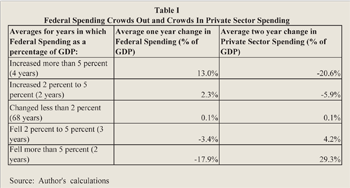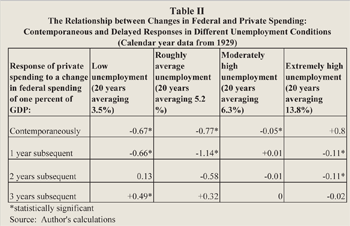Most people assume that increased government spending aids the economy and that cuts in spending will hurt it. Even more fear that government spending cuts might push the economy into a recession. These notions are based on the Keynesian belief that the economy is driven by demand.
Indeed, conventional wisdom holds that every dollar the government adds to demand (or subtracts from it) will be multiplied by ancillary changes in private spending. But these claims ignore the fact that the economy has limited economic resources and that government spending actually diverts economic resources away from the private sector. Increased government spending might induce the private sector to contract, a phenomenon known as crowding out. Conversely, cuts in government spending might release economic resources the private sector could put to work more productively.

Changes in Federal Spending, 1929-2012. Table I shows the effect of federal spending on private spending from 1929 through 2012. The amounts shown include purchases of goods and services such as national defense, but do not include transfer payments such as unemployment compensation or Social Security.
Table I also compares the effects of large versus small increases or cuts in federal spending on private sector spending. In the 68 years, from 1929 to 2012, during which federal consumption spending rose or fell by less than 2 percent of GDP (the average change was only 0.1 percent) private sector spending also rose or fell only 0.1 percent, on the average. However, large increases in federal spending had a disproportionate effect on the private sector:
- For the two years in which federal consumption spending rose by between 2 and 5 percentage points of GDP (the average increase was 2.3 percent), private sector spending fell 5.9 percentage points, on average, during that and the following year.
- For the four years in which federal consumption spending rose more than 5 percent of GDP (the average increase was 13.0 percent), private sector spending fell 20.6 percent.
Conversely, large reductions in federal spending also had a disproportionate effect on the private sector:
- For the three years in which federal consumption spending fell by between 2 and 5 percentage points of GDP (the average reduction was 3.4 percent), private sector spending rose 4.2 percentage points during that and the following year.
- For the two years in which federal consumption spending fell more than 5 percentage points of GDP, the average reduction was 17.9 percent; private sector spending rose 29.3 percentage points.
Thus, the data in the table show that not only is the cumulative private-sector response to changes in federal spending consistent, inverse and proportionate, but it appears also that a $1 increase in federal spending reduces private spending by more than $1.

Effect of Changes in Federal Spending When Unemployment Is High. John Maynard Keynes said that the economy’s resources are all put to productive use at full employment, but when the economy is depressed, increases in government spending have a multiplier effect: a $1 increase in government spending will increase private output by more than $1. At such times government can compensate for the shortfall in private spending, thereby increasing the economy’s total spending and output.
Keynes therefore recommended that deficit spending be confined to periods in which unemployment is high. Thus, Keynes himself was not a “Keynesian” in the sense of someone who believes that government spending always has a positive effect on the economy.
What effect does the unemployment rate have on the response of private spending to changes in federal spending? It depends on how high the unemployment rate was at the time.
Table II shows the private-sector responses to changes in federal spending for years grouped by the prevailing unemployment rate, allowing for a delay of up to three years in the private-sector response. The numbers in the table show whether the response of private spending to changes in federal spending is inverse, and how long it lasts, depending on the unemployment rate at the time.When unemployment was “extremely high,” it averaged 13.8 percent; when unemployment was “moderately high,” it averaged 6.3 percent; when unemployment was “roughly normal,” it averaged 5.2 percent; and when unemployment was “low,” it averaged 3.5 percent.
When unemployment is low, federal and private spending are closely and inversely related — meaning that as federal spending rises, private spending falls — and that the response of private spending is complete within a year. The estimated responses when unemployment is low range from –0.67 to +0.49; negative numbers indicate an inverse relationship. Even when unemployment is extremely high there is still an inverse relationship between federal spending and private spending, though the private-sector response is not as large. In that case the response of private spending takes two years to complete.
Conclusion.The economy has limited economic resources that federal spending cannot evade for long. On average, each additional dollar that the federal government spends on consumption or investment is soon offset by a reduction of at least a dollar in what the private sector spends. The response is smaller and slower when unemployment is high, but the delay involved rarely averages more than a year. This phenomenon has long been known as crowding out, but it seldom plays the role it should in government policy discussions. Conversely, a cut in federal spending is made up quickly by a gain in private-sector spending crowding in.
R. David Ranson is a senior fellow with the National Center for Policy Analysis and president and director of research at H.C. Wainwright & Co. Economics.